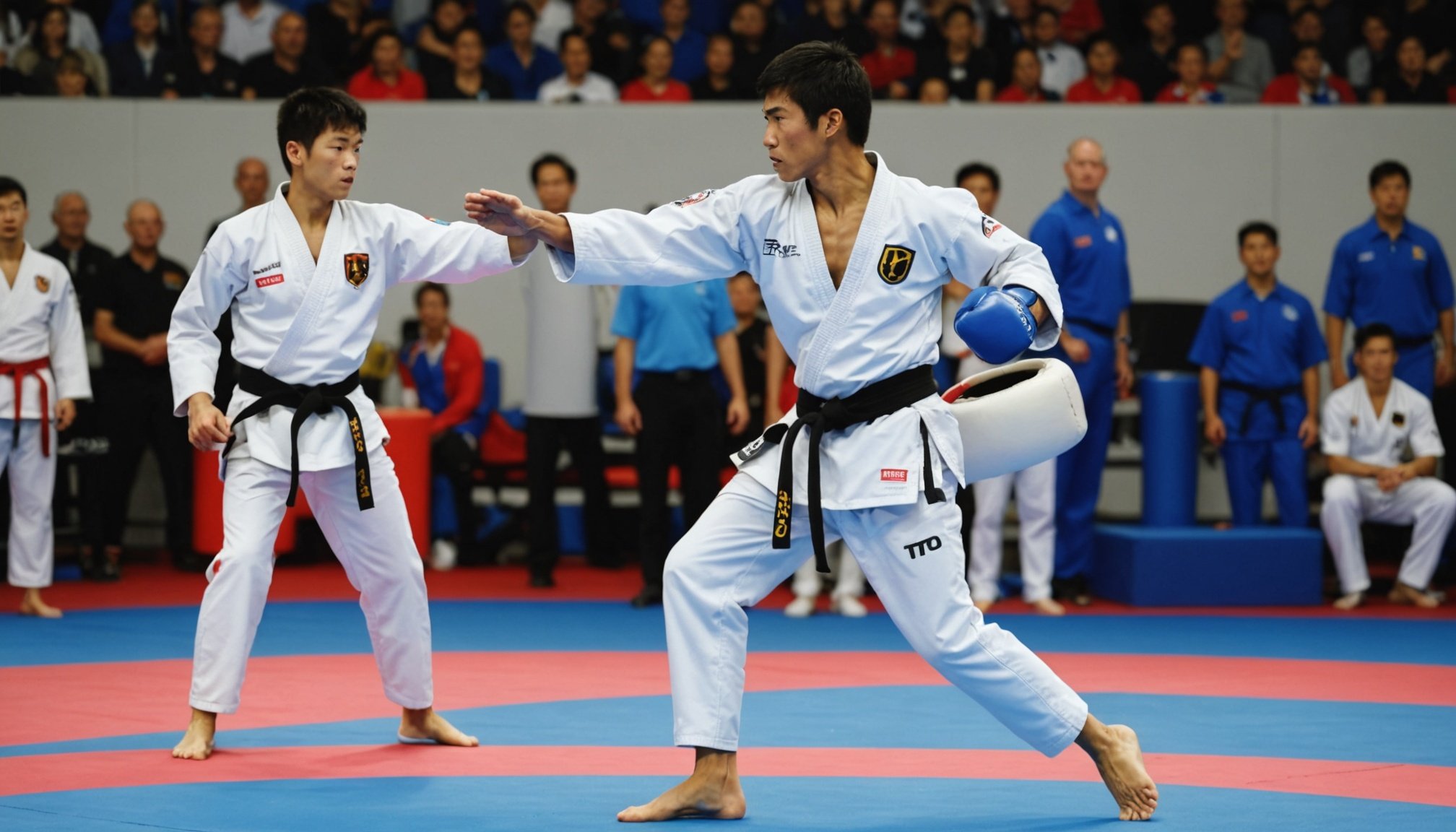Top Injury Prevention Techniques for Taekwondo Athletes in the UK: Expert Tips and Strategies
Understanding the Risks in Taekwondo
Taekwondo, a high-intensity martial art and combat sport, is renowned for its dynamic kicks, rapid movements, and intense physical demands. While it offers numerous benefits, including improved strength, flexibility, and reaction time, it also comes with a significant risk of injuries. For taekwondo athletes in the UK, particularly those at the elite and sub-elite levels, understanding and mitigating these risks is crucial for a successful and injury-free career.
Common Injuries in Taekwondo
Taekwondo athletes are prone to a variety of injuries, with the most common affecting the knee, foot, and head. Here are some of the most frequent injuries:
Also to discover : Unlocking Mental Clarity: UK Martial Artists Harnessing Meditation for Enhanced Focus and Anxiety Relief
- Knee Injuries: Ligament sprains, meniscal tears, and anterior cruciate ligament (ACL) injuries are common due to the high-impact nature of taekwondo kicks and landings.
- Foot Injuries: Fractures, sprains, and bruises are frequent due to the repetitive impact of kicks and the use of the foot as a primary striking tool.
- Head Injuries: Concussions and facial lacerations can occur from kicks and punches during sparring sessions.
Warm-Up and Cool-Down Routines
Proper warm-up and cool-down routines are essential for injury prevention in taekwondo. Here’s how athletes can benefit from these routines:
Warm-Up Routine
A thorough warm-up prepares the body for the intense physical activity ahead, reducing the risk of muscle strains and other injuries.
- Cardiovascular Warm-Up: Start with light cardio such as jogging or jumping jacks to increase heart rate and blood flow.
- Dynamic Stretching: Incorporate dynamic stretches like leg swings, arm circles, and hip rotations to loosen the muscles.
- Specific Taekwondo Movements: Gradually introduce taekwondo-specific movements like kicks, punches, and blocks to prepare the muscles and joints.
Cool-Down Routine
Cooling down after a training session or competition helps in reducing muscle soreness and preventing overuse injuries.
- Static Stretching: Focus on static stretches for the major muscle groups, including the hamstrings, quadriceps, and hip flexors.
- Foam Rolling: Use foam rolling to help reduce muscle tension and improve recovery.
- Hydration and Nutrition: Ensure adequate hydration and consume a balanced meal or snack to aid in recovery.
Strength and Conditioning Training
Strength and conditioning are vital components of a taekwondo athlete’s training regimen. Here’s how these can help in injury prevention:
Strength Training
Building strength, particularly in the core, legs, and upper body, can enhance stability and reduce the risk of injuries.
- Core Strength: Exercises like planks, Russian twists, and leg raises help stabilize the body during kicks and movements.
- Leg Strength: Squats, lunges, and deadlifts are essential for building strong legs that can withstand the impact of kicks.
- Upper Body Strength: Push-ups, pull-ups, and dumbbell rows help in improving overall body strength and stability.
Conditioning Exercises
Conditioning exercises improve endurance and reaction time, making athletes more resilient to injuries.
- High-Intensity Interval Training (HIIT): Incorporate HIIT sessions that mimic the intensity of taekwondo matches.
- Plyometric Training: Exercises like jump squats and box jumps enhance power and explosiveness.
- Agility Drills: Drills such as cone drills and ladder drills improve agility and reaction time.
Proper Technique and Training
Proper technique is the cornerstone of injury prevention in taekwondo. Here’s how athletes can ensure they are training correctly:
Mastering Taekwondo Techniques
- Kick Techniques: Focus on proper kick techniques such as the roundhouse kick, axe kick, and front kick. Ensure that the body is aligned correctly, and the kick is executed with control.
- Roundhouse Kick: Keep the chambered leg close to the body and strike with the instep.
- Axe Kick: Use the heel of the foot and keep the leg straight.
- Front Kick: Strike with the ball of the foot and keep the knee straight.
Poomsae Training
Poomsae, or forms, training helps in developing balance, coordination, and overall technique.
- Focus on Precision: Ensure that each movement is precise and controlled.
- Practice Regularly: Regular practice of poomsae helps in building muscle memory and improving technique.
Sparring Safety
Sparring is a critical component of taekwondo training but also poses a significant risk of injury if not conducted safely.
- Use Proper Gear: Always wear approved protective gear including a helmet, chest protector, arm guards, and groin protector.
- Controlled Sparring: Ensure that sparring is conducted in a controlled environment with a focus on technique rather than full-contact fighting.
Nutrition and Recovery
Proper nutrition and recovery strategies are essential for maintaining peak performance and preventing injuries.
Balanced Nutrition
A balanced diet that includes adequate protein, carbohydrates, and healthy fats is crucial for muscle repair and recovery.
- Hydration: Ensure adequate hydration by drinking plenty of water throughout the day.
- Post-Workout Nutrition: Consume a balanced meal or snack within 30-60 minutes after training to aid in recovery.
Recovery Techniques
- Rest and Sleep: Ensure adequate rest and sleep to allow the body to recover from the physical demands of training.
- Massage and Physical Therapy: Regular massages and physical therapy sessions can help in reducing muscle tension and improving recovery.
Mental Preparation and Dual Task Training
Mental preparation and dual task training can significantly enhance an athlete’s performance and reduce the risk of injuries.
Mental Preparation
- Visualization: Practice visualization techniques to mentally prepare for competitions and training sessions.
- Positive Self-Talk: Use positive self-talk to maintain confidence and focus.
Dual Task Training
Dual task training involves performing two tasks simultaneously, which can improve reaction time and reduce the risk of injuries.
- Example: Practice kicking while performing a cognitive task such as counting backwards.
- Benefits: Improves reaction time and enhances the ability to multitask during competitions.
Expert Tips and Strategies
Here are some expert tips and strategies from renowned taekwondo coaches and athletes:
Quote from a Taekwondo Coach
“Proper warm-up and cool-down routines are often overlooked but are crucial in preventing injuries. Athletes should never skip these routines, even if they feel they are in good shape,” says Coach John Smith, a veteran taekwondo coach.
Practical Insights
- Listen to Your Body: If you feel any pain or discomfort, stop training immediately and consult a medical professional.
- Seek Professional Help: Work with a qualified coach, strength and conditioning specialist, and sports physiotherapist to ensure you are training safely and effectively.
Detailed Bullet Point List: Injury Prevention Strategies
Here is a detailed list of injury prevention strategies for taekwondo athletes:
-
Warm-Up and Cool-Down Routines
-
Cardiovascular warm-up
-
Dynamic stretching
-
Specific taekwondo movements
-
Static stretching after training
-
Foam rolling
-
Hydration and nutrition
-
Strength and Conditioning Training
-
Core strength exercises (planks, Russian twists)
-
Leg strength exercises (squats, lunges)
-
Upper body strength exercises (push-ups, pull-ups)
-
High-Intensity Interval Training (HIIT)
-
Plyometric training (jump squats, box jumps)
-
Agility drills (cone drills, ladder drills)
-
Proper Technique and Training
-
Mastering kick techniques (roundhouse kick, axe kick, front kick)
-
Poomsae training
-
Controlled sparring
-
Use of proper protective gear
-
Nutrition and Recovery
-
Balanced diet
-
Hydration
-
Post-workout nutrition
-
Rest and sleep
-
Massage and physical therapy
-
Mental Preparation and Dual Task Training
-
Visualization
-
Positive self-talk
-
Dual task training
Comprehensive Table: Comparison of Injury Prevention Strategies
Here is a comprehensive table comparing different injury prevention strategies for taekwondo athletes:
| Strategy | Description | Benefits | Risks |
|---|---|---|---|
| Warm-Up and Cool-Down Routines | Cardiovascular warm-up, dynamic stretching, specific taekwondo movements, static stretching, foam rolling, hydration, and nutrition. | Reduces muscle strains, improves flexibility, aids in recovery. | None significant. |
| Strength and Conditioning Training | Core strength exercises, leg strength exercises, upper body strength exercises, HIIT, plyometric training, agility drills. | Enhances overall strength, improves endurance, reduces risk of injuries. | Overtraining if not managed properly. |
| Proper Technique and Training | Mastering kick techniques, poomsae training, controlled sparring, use of proper protective gear. | Improves technique, reduces risk of injuries, enhances performance. | None significant if done correctly. |
| Nutrition and Recovery | Balanced diet, hydration, post-workout nutrition, rest and sleep, massage and physical therapy. | Aids in recovery, improves performance, reduces risk of overuse injuries. | None significant. |
| Mental Preparation and Dual Task Training | Visualization, positive self-talk, dual task training. | Improves mental focus, enhances reaction time, reduces risk of injuries. | None significant. |
Injury prevention is a multifaceted approach that requires a combination of proper training, strength and conditioning, nutrition, recovery, and mental preparation. For taekwondo athletes in the UK, understanding and implementing these strategies can significantly reduce the risk of injuries and enhance overall performance. By focusing on warm-up and cool-down routines, strength and conditioning training, proper technique, nutrition, recovery, and mental preparation, athletes can ensure a long and successful career in this dynamic and demanding sport.
In conclusion, the key to a successful and injury-free taekwondo career lies in a holistic approach that encompasses all aspects of training, nutrition, and mental preparation. By following these expert tips and strategies, taekwondo athletes in the UK can optimize their performance and minimize the risk of injuries, ensuring they remain at the top of their game for years to come.






